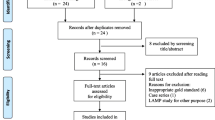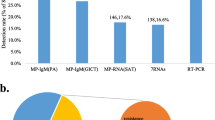Abstract
Rapid diagnosis of Mycoplasma pneumoniae pneumonia is required for treatment with effective antimicrobial agents without delay; however, this capacity has not yet been established in clinical practice. Recently, a novel nucleic acid amplification method termed loop-mediated isothermal amplification (LAMP) has been used to rapidly diagnose various infectious diseases. In this study, we prospectively evaluated the efficacy of the LAMP assay to rapidly diagnose M. pneumoniae pneumonia in clinical practice. Three hundred sixty-eight children (median age, 3.8 years; range, 0.1–14.3 years) admitted to our hospital between April 2009 and March 2010 for community-acquired pneumonia were enrolled in this study. We obtained throat swabs on admission to detect M. pneumoniae DNA and paired serum samples on admission and at discharge to assay M. pneumoniae antibody titers. M. pneumoniae pneumonia was diagnosed by either a positive LAMP assay or a fourfold or greater increase in antibody titer. Overall, 46 children (12.5% of the patients with pneumonia) were diagnosed with M. pneumoniae pneumonia; of these, 27 (58.7%) were aged less than 6 years. Of the aforementioned 46 children, 38 (82.6%) and 37 (80.4%) were identified by LAMP and serology, respectively. When the results of serology were taken as the standard, the sensitivity and specificity and positive and negative predictive values of the LAMP assay were 78.4%, 97.3%, 76.3%, and 97.6%, respectively. We concluded the LAMP assay may be useful for rapid diagnosis of M. pneumoniae pneumonia.

Similar content being viewed by others
References
Morozumi M, Hasegawa K, Chiba N, Iwata S, Kawamura N, Kuroki H, et al. Application of PCR for Mycoplasma pneumoniae detection in children with community-acquired pneumonia. J Infect Chemother. 2004;10:274–9.
Nakayama E, Hasegawa K, Morozumi M, Kobayashi R, Chiba N, Iitsuka T, et al. Rapid optimization of antimicrobial chemotherapy given to pediatric patients with community-acquired pneumonia using PCR techniques with serology and standard culture. J Infect Chemother. 2007;13:305–13.
Hamano-Hasegawa K, Morozumi M, Nakayama E, Chiba N, Murayama SY, Takayanagi R, et al. Comprehensive detection of causative pathogens using real-time PCR to diagnose pediatric community-acquired pneumonia. J Infect Chemother. 2008;14:424–32.
Nir-Paz R, Michael-Gayego A, Ron M, Block C. Evaluation of eight commercial tests for Mycoplasma pneumoniae antibodies in the absence of acute infection. Clin Microbiol Infect. 2006;12:685–8.
Ozaki T, Nishimura N, Ahn J, Watanabe N, Muto T, Saito A, et al. Utility of a rapid diagnosis kit for Mycoplasma pneumoniae pneumonia in children, and the antimicrobial susceptibility of the isolates. J Infect Chemother. 2007;13:204–7.
Michelow IC, Olsen K, Lozano J, Duffy LB, McCracken GH, Hardy RD. Diagnostic utility and clinical significance of naso- and oropharyngeal samples used in a PCR assay to diagnose Mycoplasma pneumoniae infection in children with community-acquired pneumonia. J Clin Microbiol. 2004;42:3339–41.
Kuroki H, Morozumi M, Chiba N, Ubukata K. Characterization of children with Mycoplasma pneumoniae infection detected by rapid polymerase chain reaction technique. J Infect Chemother. 2004;10:65–7.
Morozumi M, Ito A, Murayama SY, Hasegawa K, Kobayashi R, Iwata S, et al. Assessment of real-time PCR for diagnosis of Mycoplasma pneumoniae pneumonia in pediatric patients. Can J Microbiol. 2006;52:125–9.
Notomi T, Okayama H, Masubuchi H, Yonekawa T, Watanabe K, Amino N, et al. Loop-mediated isothermal amplification of DNA. Nucleic Acids Res. 2000;28:E63.
Mori Y, Notomi T. Loop-mediated isothermal amplification (LAMP): a rapid, accurate, and cost-effective diagnostic method for infectious diseases. J Infect Chemother. 2009;15:62–9.
Ihira M, Yoshikawa T, Enomoto Y, Akimoto S, Ohashi M, Suga S, et al. Rapid diagnosis of human herpesvirus 6 infection by a novel DNA amplification method, loop-mediated isothermal amplification. J Clin Microbiol. 2004;42:140–5.
Kimura H, Ihira M, Enomoto Y, Kawada J, Ito Y, Morishima T, et al. Rapid detection of herpes simplex virus DNA in cerebrospinal fluid: comparison between loop-mediated isothermal amplification and real-time PCR. Med Microbiol Immunol. 2005;194:181–5.
Iwata S, Shibata Y, Kawada J, Hara S, Nishiyama Y, Morishima T, et al. Rapid detection of Epstein–Barr virus DNA by loop-mediated isothermal amplification method. J Clin Virol. 2006;37:128–33.
Kamachi K, Toyoizumi-Ajisaka H, Toda K, Soeung SC, Sarath S, Nareth Y, et al. Development and evaluation of a loop-mediated isothermal amplification method for rapid diagnosis of Bordetella pertussis infection. J Clin Microbiol. 2006;44:1899–902.
Saito R, Misawa Y, Moriya K, Koike K, Ubukata K, Okamura N. Development and evaluation of a loop-mediated isothermal amplification assay for rapid detection of Mycoplasma pneumoniae. J Med Microbiol. 2005;54:1037–41.
Yoshino M, Annaka T, Kojima T, Ikedo M. Sensitive and rapid detection of Mycoplasma pneumoniae by loop-mediated isothermal amplification. Kansenshogaku Zasshi. 2008;82:168–76.
Uehara S, Sunakawa K, Eguchi H, Ouchi K, Okada K, Kurosaki T, et al. Japanese Guidelines for the Management of Respiratory Infectious Diseases in Children 2007 with focus on pneumonia. Pediatr Int. 2011;53:264–76.
Raty R, Ronkko E, Kleemola M. Sample type is crucial to the diagnosis of Mycoplasma pneumoniae pneumonia by PCR. J Med Microbiol. 2005;54:287–91.
Kim NH, Lee JA, Eun BW, Shin SH, Chung EH, Park KW, et al. Comparison of polymerase chain reaction and the indirect particle agglutination antibody test for the diagnosis of Mycoplasma pneumoniae pneumonia in children during two outbreaks. Pediatr Infect Dis J. 2007;26:897–903.
Colman SD, Hu PC, Bott KF. Prevalence of novel repeat sequences in and around the P1 operon in the genome of Mycoplasma pneumoniae. Gene (Amst). 1990;87:91–6.
Principi N, Esposito S, Blasi F, Allegra L. Role of Mycoplasma pneumoniae and Chlamydia pneumoniae in children with community-acquired lower respiratory tract infections. Clin Infect Dis. 2001;32:1281–9.
Defilippi A, Silvestri M, Tacchella A, Giacchino R, Melioli G, Di Marco E, et al. Epidemiology and clinical features of Mycoplasma pneumoniae infection in children. Respir Med. 2008;102:1762–8.
Morozumi M, Iwata S, Hasegawa K, Chiba N, Takayanagi R, Matsubara K, et al. Increased macrolide resistance of Mycoplasma pneumoniae in pediatric patients with community-acquired pneumonia. Antimicrob Agents Chemother. 2008;52:348–50.
Dumke R, von Baum H, Luck PC, Jacobs E. Occurrence of macrolide-resistant Mycoplasma pneumoniae strains in Germany. Clin Microbiol Infect. 2009;16:613–6.
Cao B, Zhao C, Yin Y, Zhao F, Song S, Bai L, et al. High prevalence of macrolide resistance in Mycoplasma pneumoniae isolates from adult and adolescent patients with respiratory tract infection in China. Clin Infect Dis. 2010;51:189–94.
Matsubara K, Morozumi M, Okada T, Matsushima T, Komiyama O, Shoji M, et al. A comparative clinical study of macrolide-sensitive and macrolide-resistant Mycoplasma pneumoniae infections in pediatric patients. J Infect Chemother. 2009;15:380–3.
Martinez MA, Ruiz M, Zunino E, Luchsinger V, Avendano LF. Detection of Mycoplasma pneumoniae in adult community-acquired pneumonia by PCR and serology. J Med Microbiol. 2008;57:1491–5.
Daxboeck F, Krause R, Wenisch C. Laboratory diagnosis of Mycoplasma pneumoniae infection. Clin Microbiol Infect. 2003;9:263–73.
Dorigo-Zetsma JW, Zaat SA, Wertheim-van Dillen JW, Spanjaard L, Rijntjes J, van Waveren G, et al. Comparison of PCR, culture, and serological tests for diagnosis of Mycoplasma pneumoniae respiratory tract infection in children. J Clin Microbiol. 1999;37:14–7.
Palma SC, Martinez TM, Salinas SM, Rojas GP. Asymptomatic pharyngeal carriage of Mycoplasma pneumoniae in Chilean children. Rev Chilena Infectol. 2005;22:247–50.
Kumar S, Wang L, Fan J, Kraft A, Bose ME, Tiwari S, et al. Detection of 11 common viral and bacterial pathogens causing community-acquired pneumonia or sepsis in asymptomatic patients by using a multiplex reverse transcription-PCR assay with manual (enzyme hybridization) or automated (electronic microarray) detection. J Clin Microbiol. 2008;46:3063–72.
Nilsson AC, Bjorkman P, Persson K. Polymerase chain reaction is superior to serology for the diagnosis of acute Mycoplasma pneumoniae infection and reveals a high rate of persistent infection. BMC Microbiol. 2008;8:93.
Thurman KA, Walter ND, Schwartz SB, Mitchell SL, Dillon MT, Baughman AL, et al. Comparison of laboratory diagnostic procedures for detection of Mycoplasma pneumoniae in community outbreaks. Clin Infect Dis. 2009;48:1244–9.
Reznikov M, Blackmore TK, Finlay-Jones JJ, Gordon DL. Comparison of nasopharyngeal aspirates and throat swab specimens in a polymerase chain reaction-based test for Mycoplasma pneumoniae. Eur J Clin Microbiol Infect Dis. 1995;14:58–61.
Gnarpe J, Lundback A, Gnarpe H, Sundelof B. Comparison of nasopharyngeal and throat swabs for the detection of Chlamydia pneumoniae and Mycoplasma pneumoniae by polymerase chain reaction. Scand J Infect Dis Suppl. 1997;104:11–2.
Dorigo-Zetsma JW, Verkooyen RP, van Helden HP, van der Nat H, van den Bosch JM. Molecular detection of Mycoplasma pneumoniae in adults with community-acquired pneumonia requiring hospitalization. J Clin Microbiol. 2001;39:1184–6.
Conflict of interest
The authors did not receive any financial support from any third party
Author information
Authors and Affiliations
Corresponding author
About this article
Cite this article
Gotoh, K., Nishimura, N., Ohshima, Y. et al. Detection of Mycoplasma pneumoniae by loop-mediated isothermal amplification (LAMP) assay and serology in pediatric community-acquired pneumonia. J Infect Chemother 18, 662–667 (2012). https://doi.org/10.1007/s10156-012-0388-5
Received:
Accepted:
Published:
Issue Date:
DOI: https://doi.org/10.1007/s10156-012-0388-5




